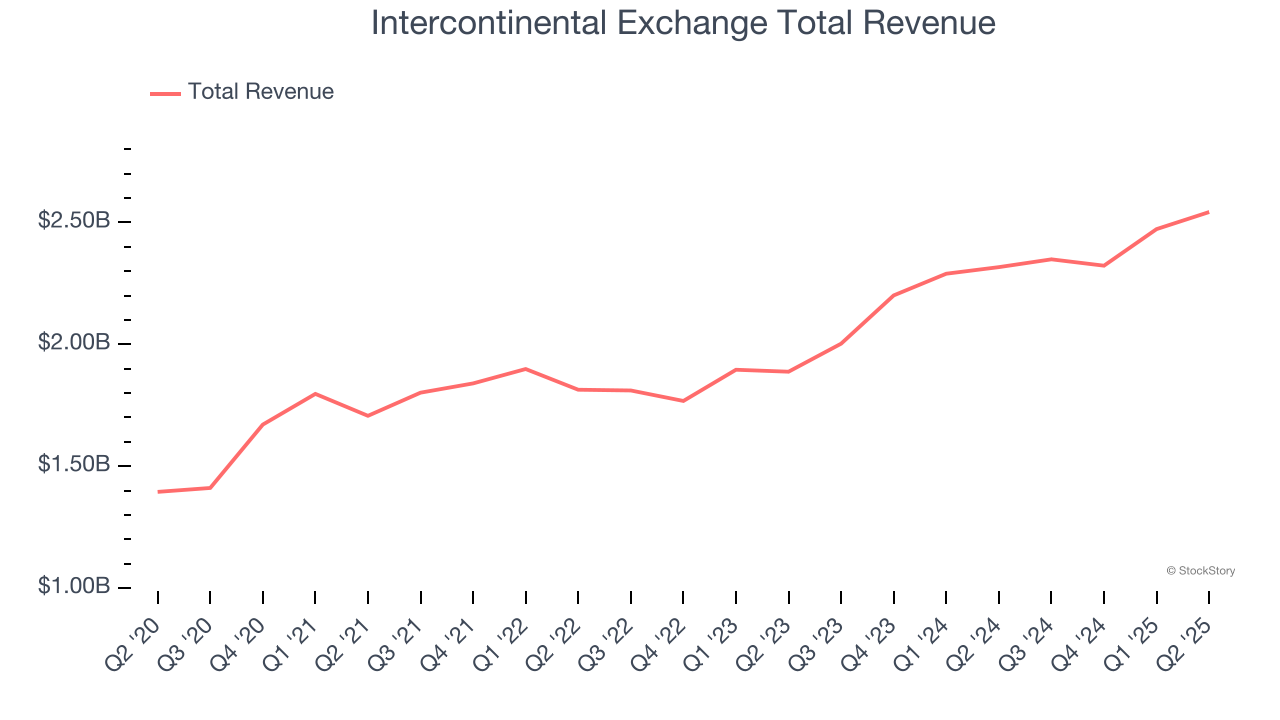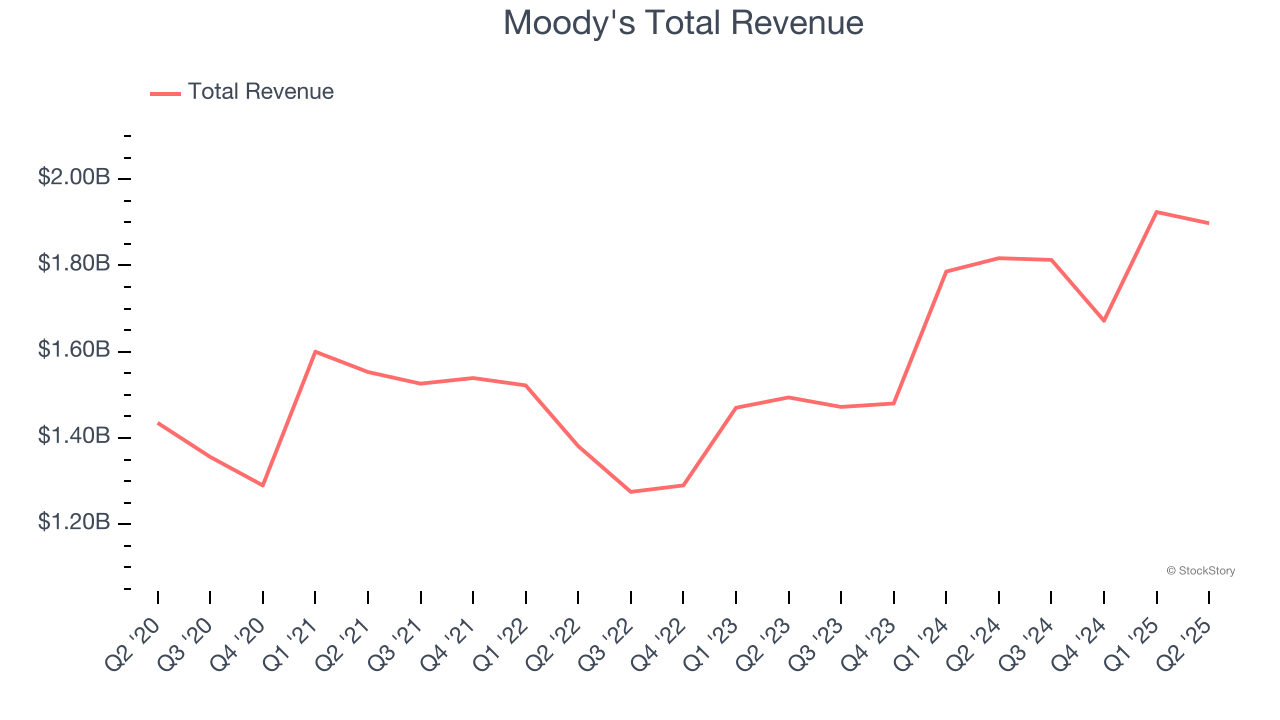
The end of an earnings season can be a great time to discover new stocks and assess how companies are handling the current business environment. Let’s take a look at how Intercontinental Exchange (NYSE: ICE) and the rest of the financial exchanges & data stocks fared in Q2.
Financial exchanges and data providers operate trading platforms and sell market information. They enjoy relatively stable revenue from trading fees and subscriptions, increasing demand for data analytics, and expansion opportunities in emerging markets. Challenges include regulatory oversight of market structure, competition from alternative trading venues, and substantial technology investments needed to maintain low-latency trading infrastructure and data security.
The 9 financial exchanges & data stocks we track reported a mixed Q2. As a group, revenues beat analysts’ consensus estimates by 1%.
Amidst this news, share prices of the companies have had a rough stretch. On average, they are down 5.5% since the latest earnings results.
Intercontinental Exchange (NYSE: ICE)
Starting as an energy trading platform in 2000 before acquiring the iconic New York Stock Exchange in 2013, Intercontinental Exchange (NYSE: ICE) operates global financial exchanges, clearing houses, and provides data services and mortgage technology solutions to financial institutions and corporations.
Intercontinental Exchange reported revenues of $2.54 billion, up 9.8% year on year. This print was in line with analysts’ expectations, but overall, it was a mixed quarter for the company with a beat of analysts’ EPS estimates but a slight miss of analysts’ Exchanges segment estimates.

Unsurprisingly, the stock is down 6.7% since reporting and currently trades at $173.46.
Is now the time to buy Intercontinental Exchange? Access our full analysis of the earnings results here, it’s free.
Best Q2: Moody's (NYSE: MCO)
Founded in 1900 during America's railroad boom when investors needed reliable information on bond risks, Moody's (NYSE: MCO) provides credit ratings, risk assessment tools, and analytical solutions that help organizations evaluate financial risks and make informed investment decisions.
Moody's reported revenues of $1.90 billion, up 4.5% year on year, outperforming analysts’ expectations by 2.9%. The business had a strong quarter with a solid beat of analysts’ Investor Services segment estimates and an impressive beat of analysts’ EBITDA estimates.

Moody's delivered the biggest analyst estimates beat among its peers. The market seems content with the results as the stock is up 1.6% since reporting. It currently trades at $507.
Is now the time to buy Moody's? Access our full analysis of the earnings results here, it’s free.
Weakest Q2: Tradeweb Markets (NASDAQ: TW)
Founded in 1996 as one of the pioneers in electronic bond trading, Tradeweb Markets (NASDAQ: TW) builds and operates electronic marketplaces that connect financial institutions for trading across rates, credit, equities, and money markets.
Tradeweb Markets reported revenues of $513 million, up 26.7% year on year, in line with analysts’ expectations. It was a slower quarter as it posted a significant miss of analysts’ EPS estimates and transaction volumes in line with analysts’ estimates.
As expected, the stock is down 13.7% since the results and currently trades at $119.26.
Read our full analysis of Tradeweb Markets’s results here.
FactSet (NYSE: FDS)
Founded in 1978 when financial data was still primarily delivered through paper reports, FactSet (NYSE: FDS) provides financial data, analytics, and technology solutions that investment professionals use to research, analyze, and manage their portfolios.
FactSet reported revenues of $585.5 million, up 5.9% year on year. This print surpassed analysts’ expectations by 0.7%. Taking a step back, it was a mixed quarter as it also produced a decent beat of analysts’ EBITDA estimates but a miss of analysts’ EPS estimates.
The stock is down 11.8% since reporting and currently trades at $373.
Read our full, actionable report on FactSet here, it’s free.
CME Group (NASDAQ: CME)
Born from the Chicago Mercantile Exchange founded in 1898 as a butter and egg trading venue, CME Group (NASDAQ: CME) operates the world's largest derivatives marketplace where traders can buy and sell futures and options contracts across interest rates, equities, currencies, commodities, and more.
CME Group reported revenues of $1.69 billion, up 10.5% year on year. This number met analysts’ expectations. Aside from that, it was a mixed quarter as it underperformed in some other aspects of the business.
The stock is down 5.2% since reporting and currently trades at $260.50.
Read our full, actionable report on CME Group here, it’s free.
Market Update
The Fed’s interest rate hikes throughout 2022 and 2023 have successfully cooled post-pandemic inflation, bringing it closer to the 2% target. Inflationary pressures have eased without tipping the economy into a recession, suggesting a soft landing. This stability, paired with recent rate cuts (0.5% in September 2024 and 0.25% in November 2024), fueled a strong year for the stock market in 2024. The markets surged further after Donald Trump’s presidential victory in November, with major indices reaching record highs in the days following the election. Still, questions remain about the direction of economic policy, as potential tariffs and corporate tax changes add uncertainty for 2025.
Want to invest in winners with rock-solid fundamentals? Check out our Top 5 Quality Compounder Stocks and add them to your watchlist. These companies are poised for growth regardless of the political or macroeconomic climate.
StockStory is growing and hiring equity analyst and marketing roles. Are you a 0 to 1 builder passionate about the markets and AI? See the open roles here.




